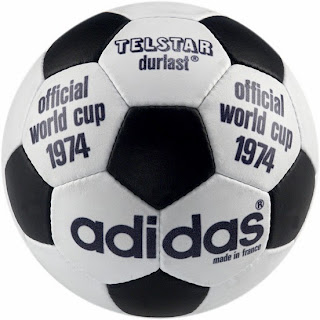Brazil Worl Cup 2014
Source: http://www.nytimes.com/interactive/2014/06/13/sports/worldcup/world-cup-balls.html?ref=world&_r=0
The T-model with 5 laces that was used in the first World Cup final is now kept in a museum in Manchester in England
URUGUAY930
Uruguay 1930
T-Model
T-Model
An Imperfect Ball
Early soccer balls were hand-sewn and made of leather. They were never perfectly round, and inflating them required some skill. The laces had to be undone before an interior air bladder was filled and tied with a thread; then the laces were retied.
Team captains chose a ball before each match, and every team had a preferred design, according to Peter Pesti, a collector and expert on World Cup balls. In the first World Cup, in 1930, Uruguay and Argentina could not agree on which ball to use. The first half of the match was played with a model favored by Argentina. The second half was played with Uruguay’s preferred design, the T-Model. Argentina led, 2-1, after the first half, but Uruguay recovered in the second and won, 4-2.
Argentina scoring against the United States in a 1930 semifinal match.
The heavy leather laces of early balls made headers potentially painful, and relatively rare. A later innovation in valve design eliminated the laces. The new balls were much easier to head, and they held their shape better.
Italy 1934
Federale 102
Federale 102
France 1938
Allen
Brazil 1950
Superball Duplo T
Switzerland 1954
Swiss World Champion
Sweden 1958
Sweden Top Star
Chile 1962
Crack
England 1966
Challenge 4-Stars
The heavy leather laces of early balls made headers potentially painful, and relatively rare. A later innovation in valve design eliminated the laces. The new balls were much easier to head, and they held their shape better.
An English midfielder trying to head the ball at the tournament in 1950.
The Superball Duplo T was the first World Cup ball without laces.
Made for TV
The 1970 World Cup was broadcast by satellite in both Europe and the Americas, and the Telstar Durlast was designed to be television friendly. The enduring black-and-white pattern was said to improve visibility on black-and-white sets.
and-white pattern was said to improve visibility on black-and-white sets.
Mexico 1970
Telstar Durlast
Telstar Durlast
The construction of the ball was innovative as well. Older balls, with horizontal and vertical stripes, resembled volleyballs. Adi Dassler, a founder of Adidas, broke away by choosing a 32-panel design that made the ball more spherical, allowing for improved ball control.
The new construction set the standard for the next three decades of World Cup balls, with leather eventually giving way to synthetics. Meanwhile, Adidas has provided the ball for every tournament since 1970.
Brazil’s Pelé with the Telstar in a match against England, 1970,
the year in which Pelé cemented his reputation as one of the greatest players of all time.
Germany 1074
Telstar Durlast
Argentina 1978
Tango River plate
Spain 1982
Tango España
Mexico 1986
Azteca
Italy 1990
Etrusco Unico
United States 1994
Questra
France 1998
Tricolore
Korea/Japan 2002
Fevernova
A New Geometry
The newest balls are heat-sealed, with fewer panels and a more aerodynamic seam pattern. Though these balls were designed to perform more uniformly, the Jabulani design was harshly criticized at the 2010 World Cup. Many players complained that the ball’s trajectory was fickle and unpredictable.
Adidas has said that this year’s ball, the Brazuca, has gone through rigorous testing in advance of the tournament.
Germany 2006
Teamgeist
South Africa 2010
Jabulani
Brazil 2014
Brazuca
Brazuca
Sources: Peter Pesti, worldcupballs.info; Adidas; Fabian Flores.





























No comments:
Post a Comment